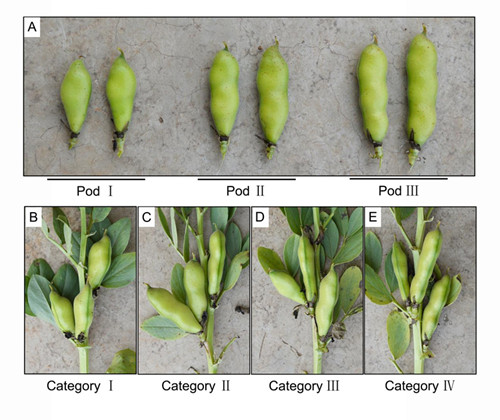Broad bean (Vicia faba L.) is an important leguminous crop worldwide. It is extensively used as a grain, a vegetable, a fodder etc. because of its nutrient-rich seeds. In China, broad bean is widely cultivated in Sichuan, Yunnan, Guizhou, Hunan, Hubei, Jiangsu, Zhejiang, and Qinghai provinces, and the planting area and total production both account for over half of those worldwide. Like other grain crops, an increase in the seed yield of broad bean will increase both the grain reserve and the profit for farmers. Previous studies on increasing the seed yield of broad bean have mainly focused on breeding new varieties, improving environmental conditions, and improving agricultural management on the whole population level; however, little attention has been paid to the contributions of different plant types or pod types within the population to the seed yield.
Under the supervision of Profs. YANG Yongping, at Kunming Institute of Botany, Ph. D. student LI Xiong, combined with the agricultural practice and field observation. The research found that the local mature pods of broad bean could be divided into three types according to the seeds number per pod. These have been designated as Pod I (containing one seed), Pod II (two seeds), and Pod III (three seeds). Based on the pod types, the broad bean plants can be classified into four categories: Category I, all pods are Pod I; Category II, all pods are Pod II ; Category III, pods are either Pod I or Pod II; and Category IV, at least one Pod III is among the pods. Through investigating and analyzing 15 quadrats of 2 × 2 m2 in the farmland, the authors found that the distribution of four plant categories in the unit area of farmland varied greatly and was consistent the statistics rule. Therefore, if different plant categories have diverse average seed yields, change the distribution ratio of per unit area will affect the total seed yield of broad bean. With the statistics and measurement of 50 plant individuals for each plant category, the average pods number, seeds number and single seed weight per plant were calculated, respectively. Correlation analysis showed that there was a trade-off between the pod size and number, which resulted in different plant categories containing different number of seeds; however, single seed weight of different plant categories had no difference. Thus, broad bean seed yield per plant was decided by the seeds number. When the distribution proportion of different plant categories in unit area hypothetically increased by 10% or up to 100%, total seed yield of broad bean per unit area were greatly affected. Inside, the increase in plant Category II could most effectively improve the total seed yield of broad bean. Similarly, the analysis results about three pod types also showed that the increase in Pod II could most effectively improve the total seed yield of broad bean..
The study indicated that it would help to improve the seed yield of broad bean if the allocation proportion of different plant categories (or pod types) within the population could be controlled, when the condition of broad bean varieties and planting density was certain. However, the reasons that lead to the generation and allocation of different plant categories (or pod types) still need further study. The present study was published on the international journal Scientific Reports with the title of “A novel perspective on seed yield of broad bean (Vicia faba L.): differences resulting from pod characteristics”. http://www.nature.com/srep/2014/141031/srep06859/full/srep06859.html

(A) Morphology of Pod I, Pod II, and Pod III. Morphology of plants in Category I (B), Category II (C), Category III (D), and Category IV (E).(Image by KIB)




